

高等学校化学学报 ›› 2023, Vol. 44 ›› Issue (5): 20220727.doi: 10.7503/cjcu20220727
收稿日期:2022-11-19
出版日期:2023-05-10
发布日期:2023-02-06
通讯作者:
古兴兴,赖超
E-mail:x.gu@ctbu.edu.cn;laichao@jsnu.edu.cn
基金资助:
TU Xingchao1, GU Xingxing2( ), LAI Chao1(
), LAI Chao1( )
)
Received:2022-11-19
Online:2023-05-10
Published:2023-02-06
Contact:
GU Xingxing, LAI Chao
E-mail:x.gu@ctbu.edu.cn;laichao@jsnu.edu.cn
Supported by:摘要:
金属锂具有超高理论比容量密度(3680 mA·h·g‒1)和低还原电位(‒3.04 V vs. SHE), 被认为是高能量密度电池负极材料的“圣杯”. 然而, 由于锂枝晶不可控生长和对电解质高反应性导致的库仑效率低、 循环寿命短及内短路等问题严重制约着金属锂负极的实用化进展. 在实际的电化学体系中, 集流体作为金属锂沉积/脱出的基底, 其表面性质对锂负极的循环稳定性起着至关重要的作用. 本文从负极、 集流体表面成分以及微结构设计两方面系统总结了构建三维亲锂骨架材料的改性策略. 利用金属、 金属氧化物、 杂原子掺杂、 聚合物材料及有机框架材料等高亲锂材料对集流体和负极的界面及结构进行针对性调控修饰, 可以有效调控金属锂的电沉积, 推进金属锂负极在高能量密度电池体系中的实用化进程.
中图分类号:
TrendMD:
屠兴超, 古兴兴, 赖超. 基于三维亲锂材料的高稳定金属锂负极的构筑. 高等学校化学学报, 2023, 44(5): 20220727.
TU Xingchao, GU Xingxing, LAI Chao. Construction of Highly Stable Lithium Metal Anode Based on Three Dimensional Lipophilic Materials. Chem. J. Chinese Universities, 2023, 44(5): 20220727.
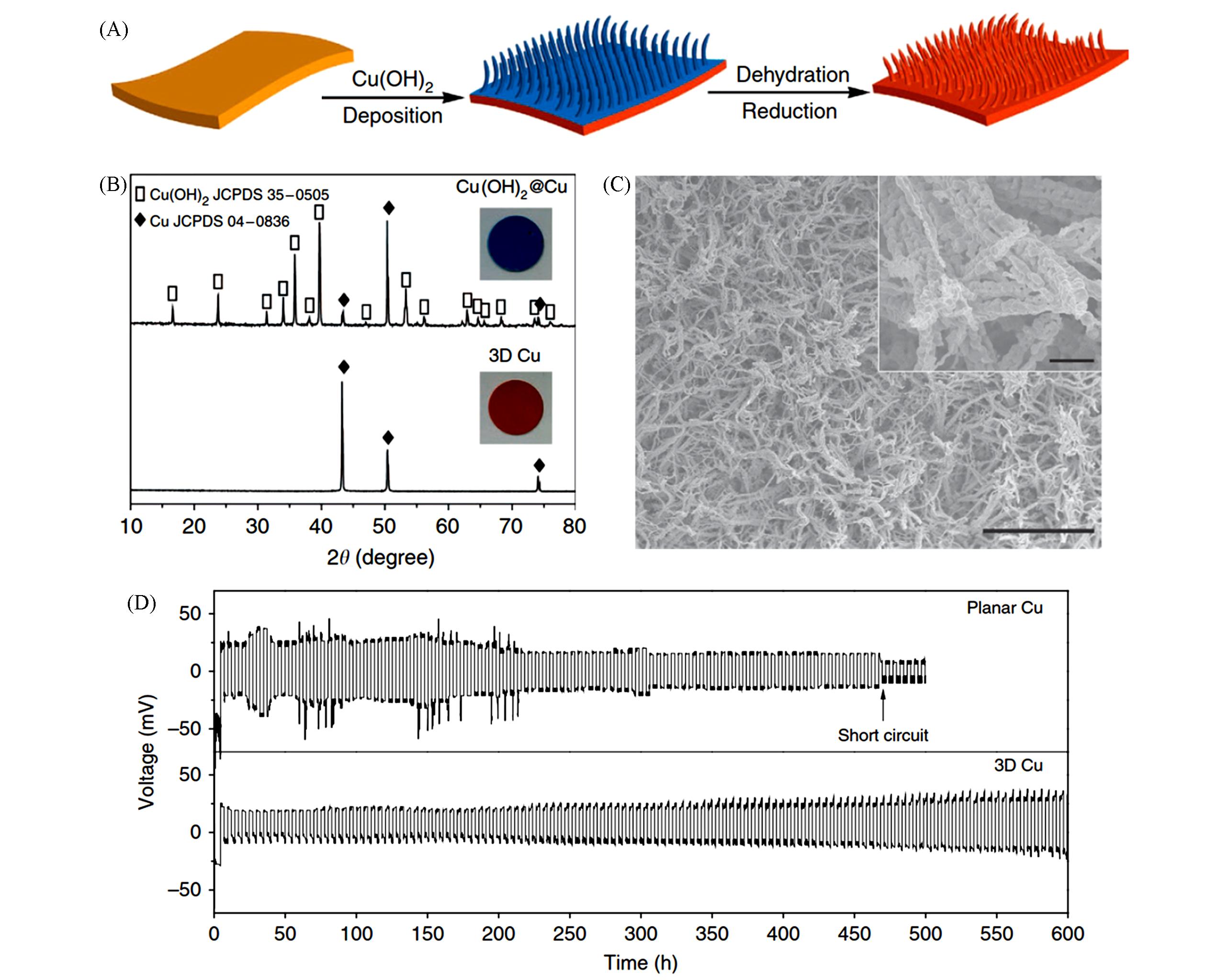
Fig.1 Schematic presentation of the procedures to prepare a 3D porous Cu foil from a planar Cu foil(A), X⁃ray diffraction profiles of Cu(OH)2 on the Cu foil and the final 3D Cu foil(B), SEM image of the porous Cu(scale bar, 50 mm, C), voltage profiles and average voltage hysteresis of Li metal plating/stripping at 0.2 mA/cm2 in symmetric Li|Li@Cu cells with planar or 3D Cu foil as current collector(D)[41]Insets: (B) digital images of the corresponding samples; (C) high-magnification image, scale bar, 2 mm.Copyright 2015, Macmillan Publishers Limited.
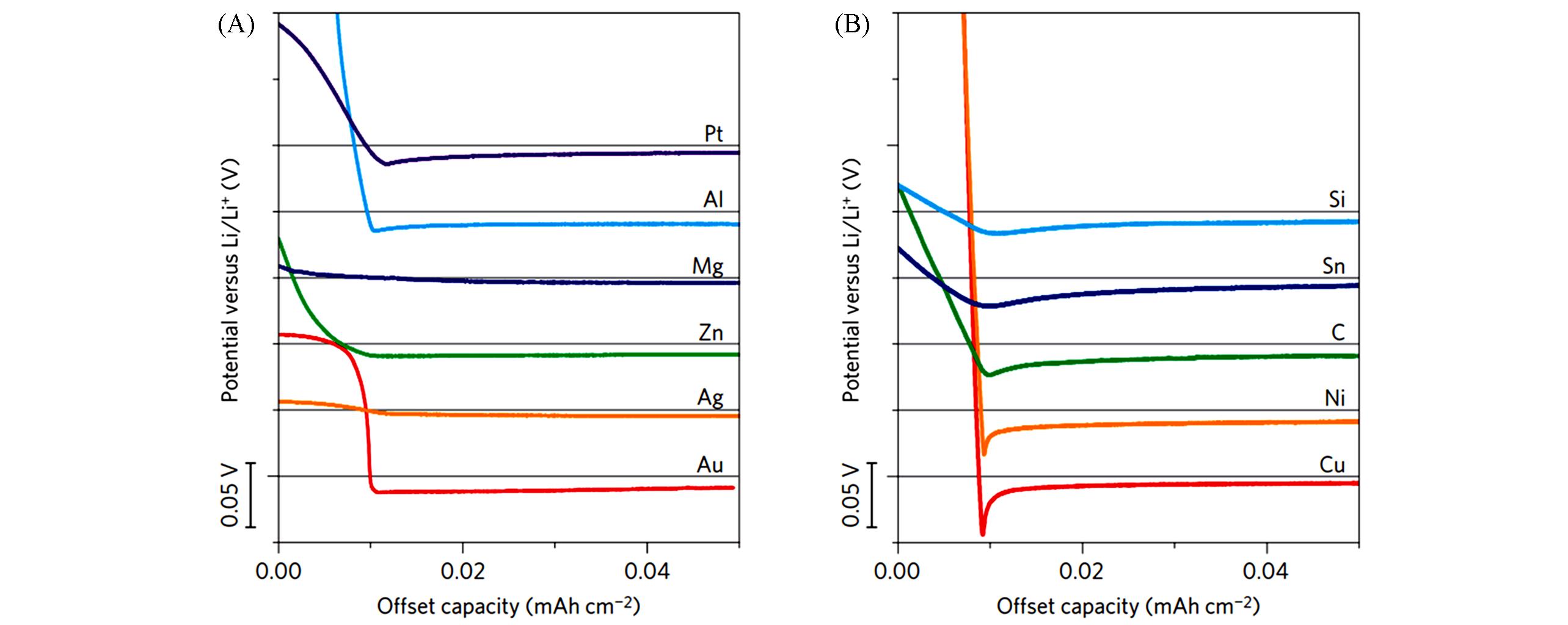
Fig.2 Voltage profiles of various materials with some solubility in Li during Li deposition at a current density of 10 µA/cm2(A) and shifted voltage profiles of various materials with negligible solubility in Li during Li deposition at a current density of 10 µA/cm2(B)[43](A) To enhance the comparison, the curves are shifted horizontally according to the onset of lithium nucleation and vertically with a constant shift of 0.05 V; the scale of the y-axis is indicated by the bar in the bottom left; the horizontal grey lines show 0 V versus Li in (A) and (B).Copyright 2016, Macmillan Publishers Limited.
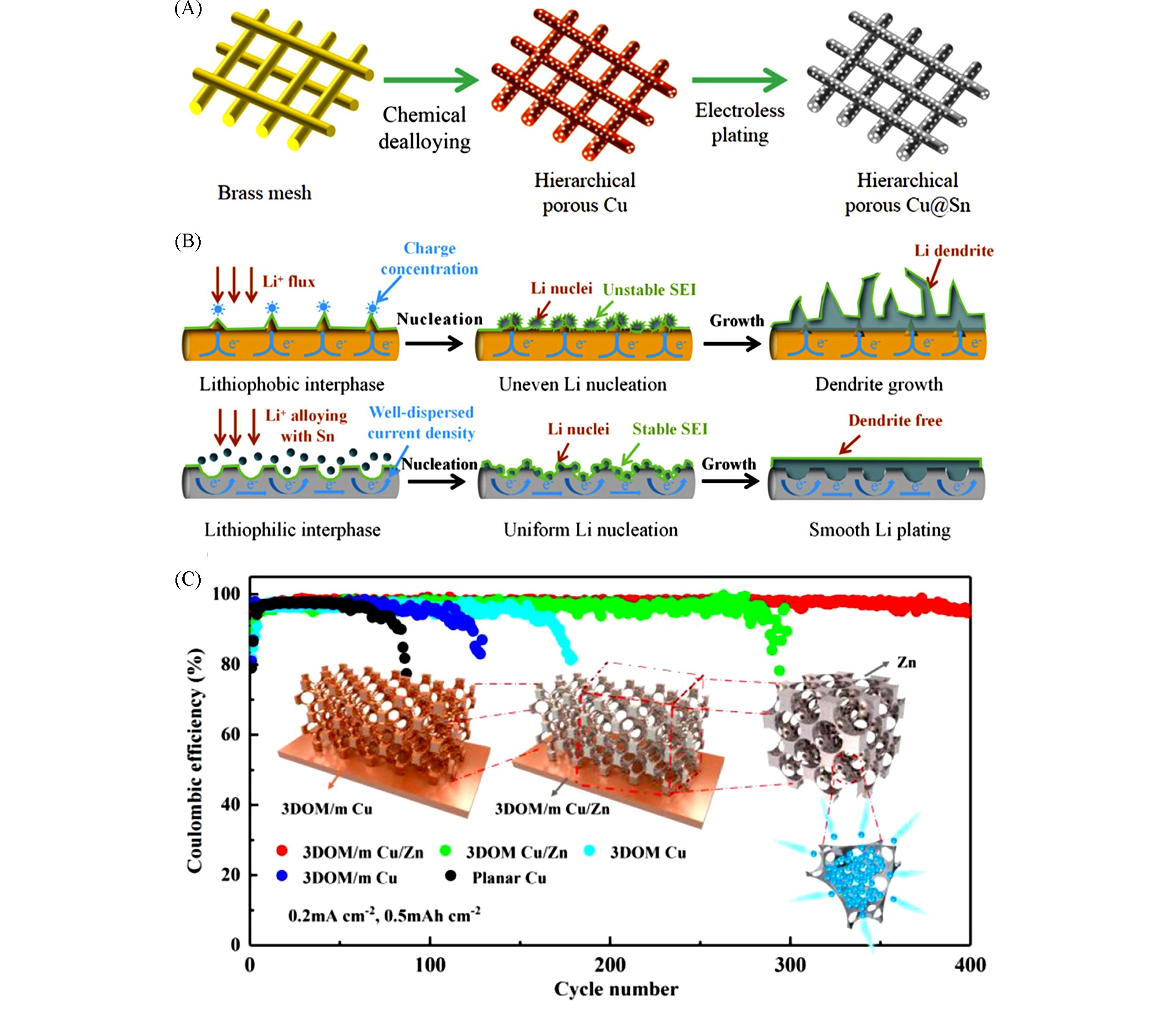
Fig.3 Schematic diagram illustrating the preparation process of HP⁃Cu@Sn current collector(A), schematic representation of different Li metal deposition behavior on brass mesh and HP⁃Cu@Sn(B)[44] and coulombic efficiency for varying current collector cycles at current density of 0.5 mA·h·cm-2(C)[45](A, B) Copyright 2020, Elsevier; (C) Copyrights 2019, American Chemical Society.
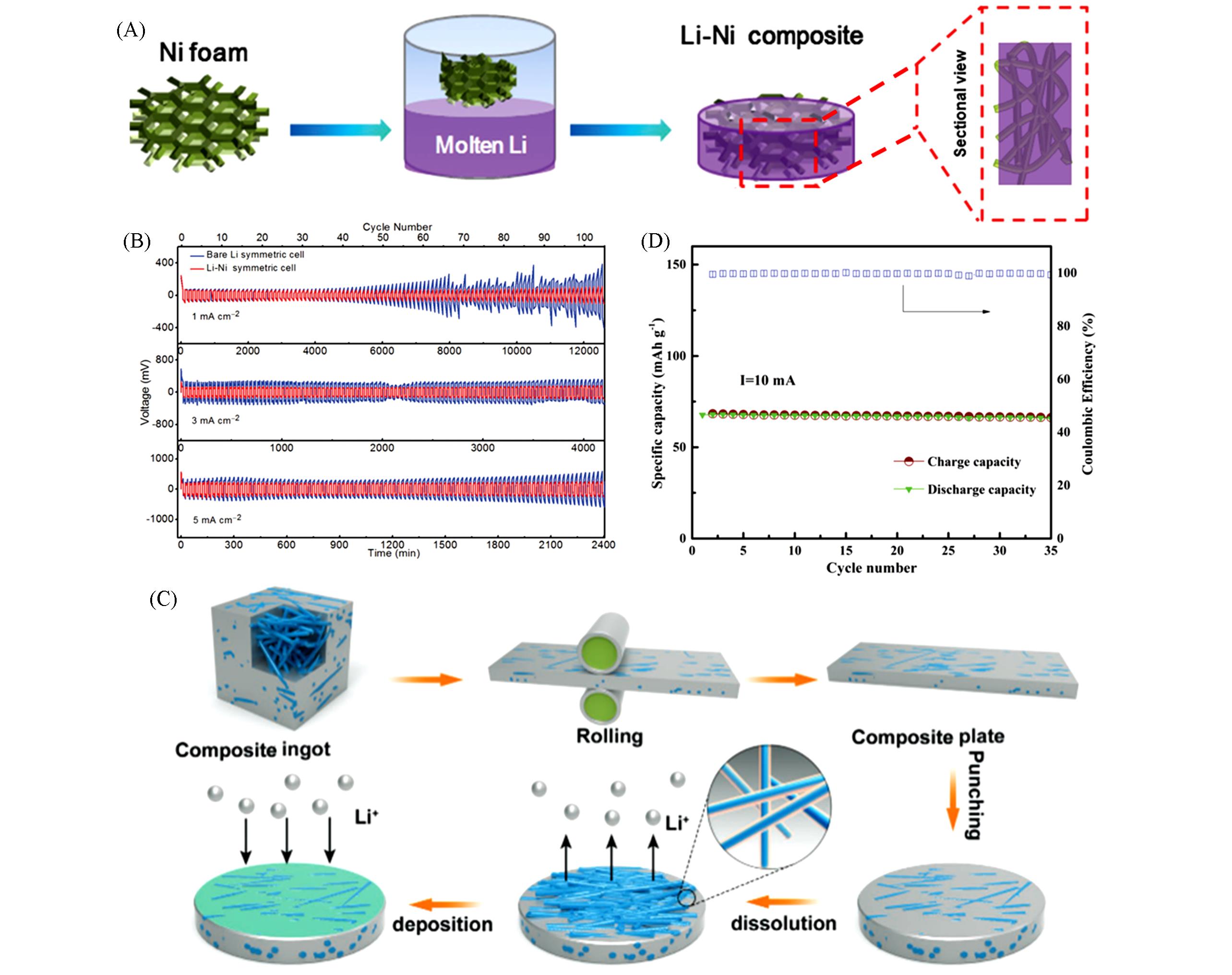
Fig.4 Schematic of Li⁃Ni anode fabrication process(A), comparison of the cycling stability of the Li⁃Ni composite (red) and bare Li electrode(blue) symmetrical cell at a current density of 1, 3, and 5 mA/cm2(B)[60], the schematic diagram for the fabrication course and the Li electrodissolution/electrodeposition process of Li⁃B⁃Mg composite(C), cycling performance of pouch⁃type batteries using LiCoO2 as cathode and Li⁃B⁃Mg as anode in carbonate⁃based electrolyte(D)[61](A, B) Copyright 2017, Wiley-VCH Verlag GmbH & Co. KGaA, Weinheim; (C, D) Copyright 2020, Wiley-VCH Verlag GmbH & Co. KGaA, Weinheim.
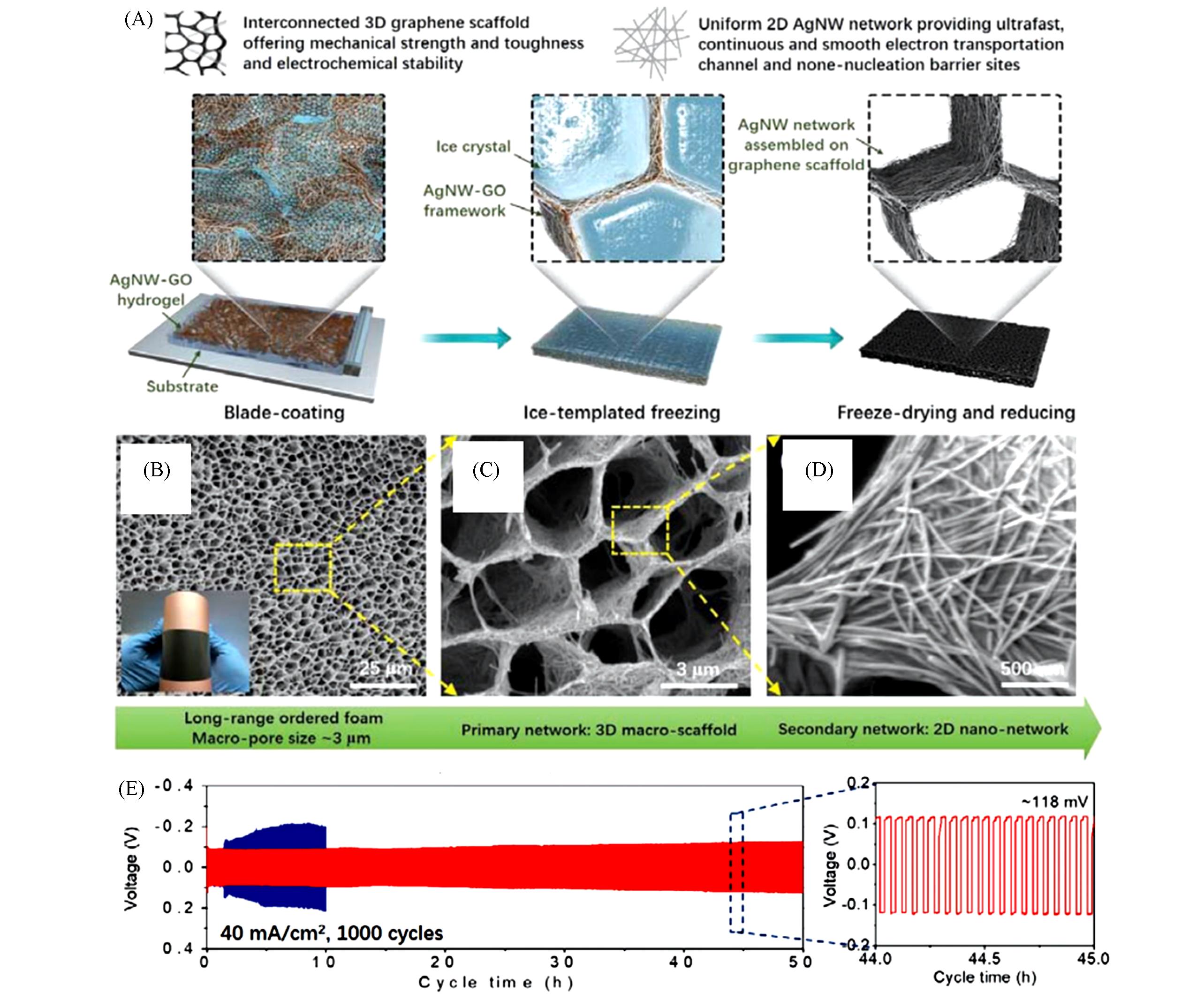
Fig.5 Schematic of the solution⁃based fabrication process of hierarchical 3D⁃AGBN host(A), cross⁃sectional SEM images under different magnifications for an optimized 3D⁃AGBN host with hierarchical binary network structure(B—D) and cycling performance comparisons of symmetrical cells using bare Li foil(blue) and Li@3D⁃AGBN composite anode(red) under current densities of 40 mA/cm2 with a fixed apacity of 1 mA·h·cm-2(E)[83]Inse of (B): as-prepared flexible 3D-AGBN host on the substrate.Copyright 2018, Wiley-VCH Verlag GmbH & Co. KGaA, Weinheim.
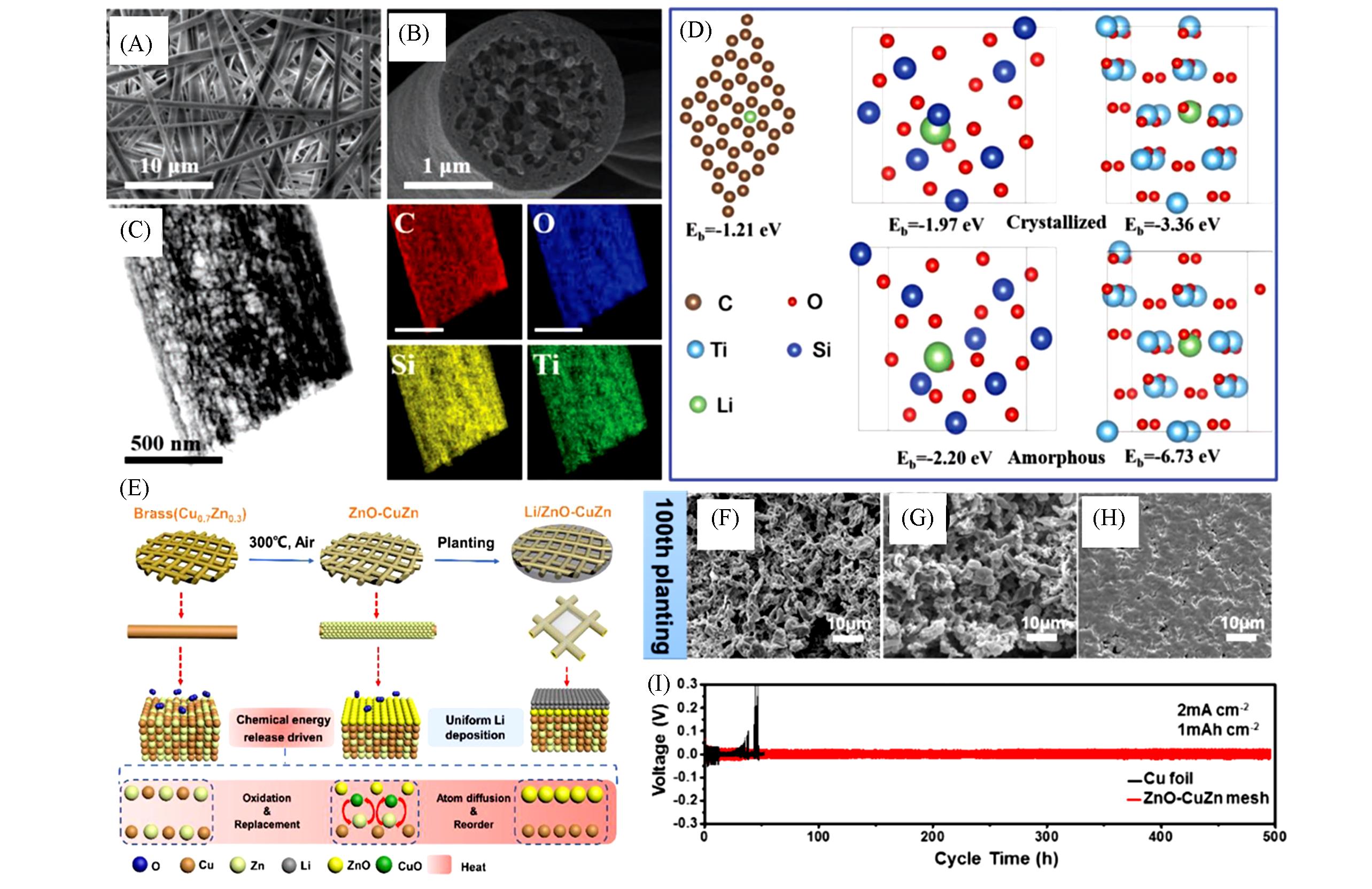
Fig.6 Top⁃view SEM images of the top surface of the PCSF(A), cross⁃sectional SEM image of PCSF hosts with a fiber diameter of 1—2 µm(B), element mapping analysis of PCSF composite(C), optimized geometrical structures and corresponding binding energies of a Li atom adsorbed on carbon, SiO2(101) surface, TiO2(101) surface, amorphous SiO2, and amorphous TiO2(D)[91], chemical energy release driven surface atom diffusion strategy to in situ achieve a lithiophilic layer on a commercial 3D brass mesh as a modified current collector via a simple air thermal treatment(E), SEM images of the Cu foil(F), Cu⁃Zn mesh(G) and ZnO⁃CuZn mesh(H) after the 100th cycles, and voltage⁃time curves of the Cu foil and ZnO⁃CuZn mesh in symmetrical cells with a cycling capacity of 1 mA·h·cm-2 at current densities of 2 mA/cm2(I)[88](A—D) Copyright 2019, Wiley-VCH Verlag GmbH & Co. KGaA, Weinheim; (E—I) Copyright 2019, American Chemical Society.
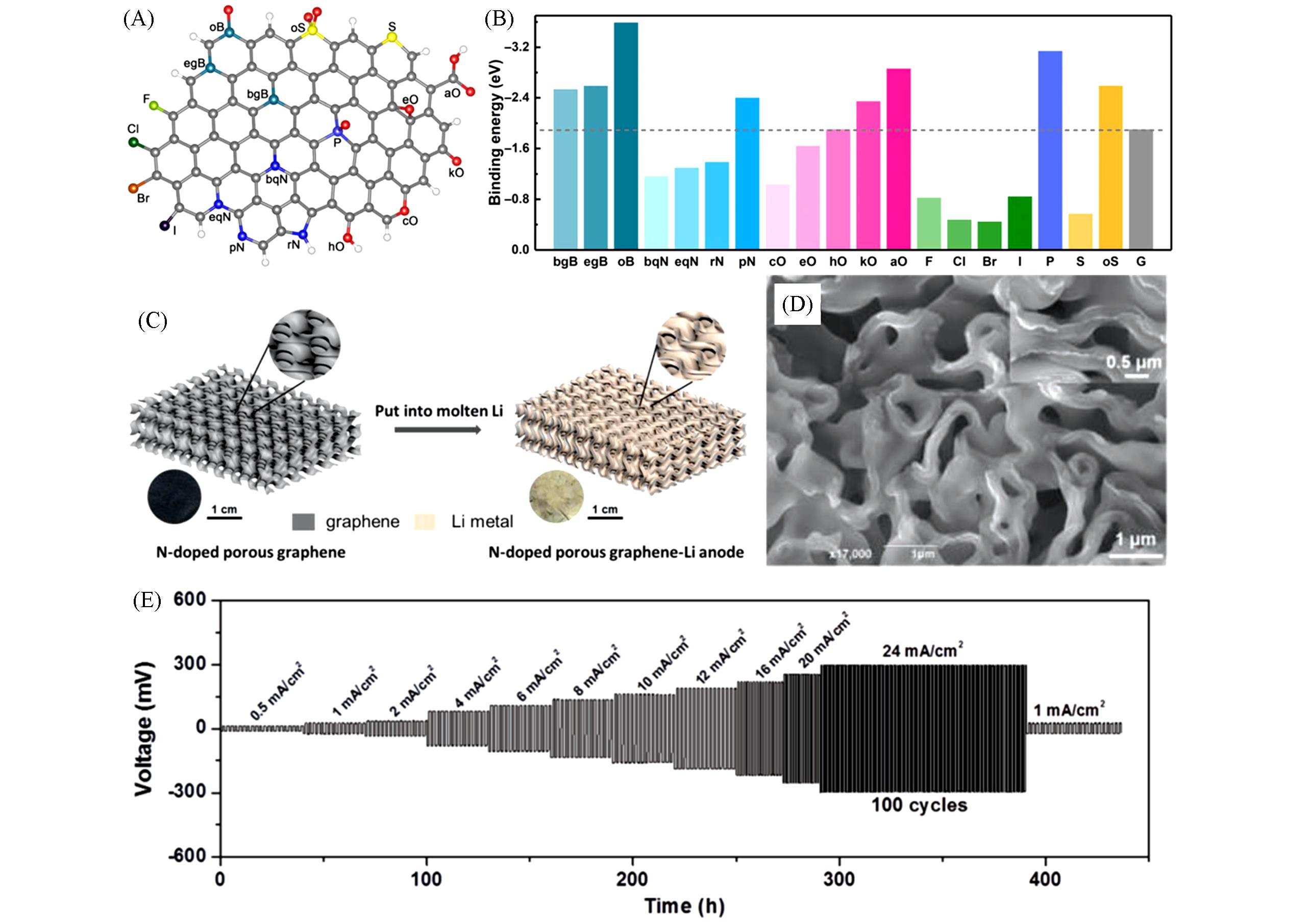
Fig.7 Modeling of heteroatom⁃doped carbons(A), summary of calculated bindingenergy between heteroatom⁃doped carbon and a Li atom(B)[120], schematic illustration of the fabrication process of the nanoporous N⁃doped graphene⁃Li anode(C), SEM image of nanoporous N⁃doped graphene⁃L(D), rate performance of N⁃doped graphene⁃Li electrodes measured at current densities ranging from 0.5 to 12 mA/cm2 for 1 h and from 16 to 24 mA/cm2 at the area capacity of 12 mA·h·cm-2 in both the stripping/plating processes of each cycle(E)[121](B) The hydrogen, boron, carbon, nitrogen, oxygen, fluorine, phosphorus, sulfur, chlorine, bromine, and iodine atoms are marked as white, green, gray, blue, red, cyan, wathet, yellow, bottle green, orange, and black, respectively.(A, B) Copyright 2019, American Association for the Advancement of Science(AAAS); (C—E) Copyright 2019, Wiley-VCH Verlag GmbH & Co. KGaA, Weinheim.
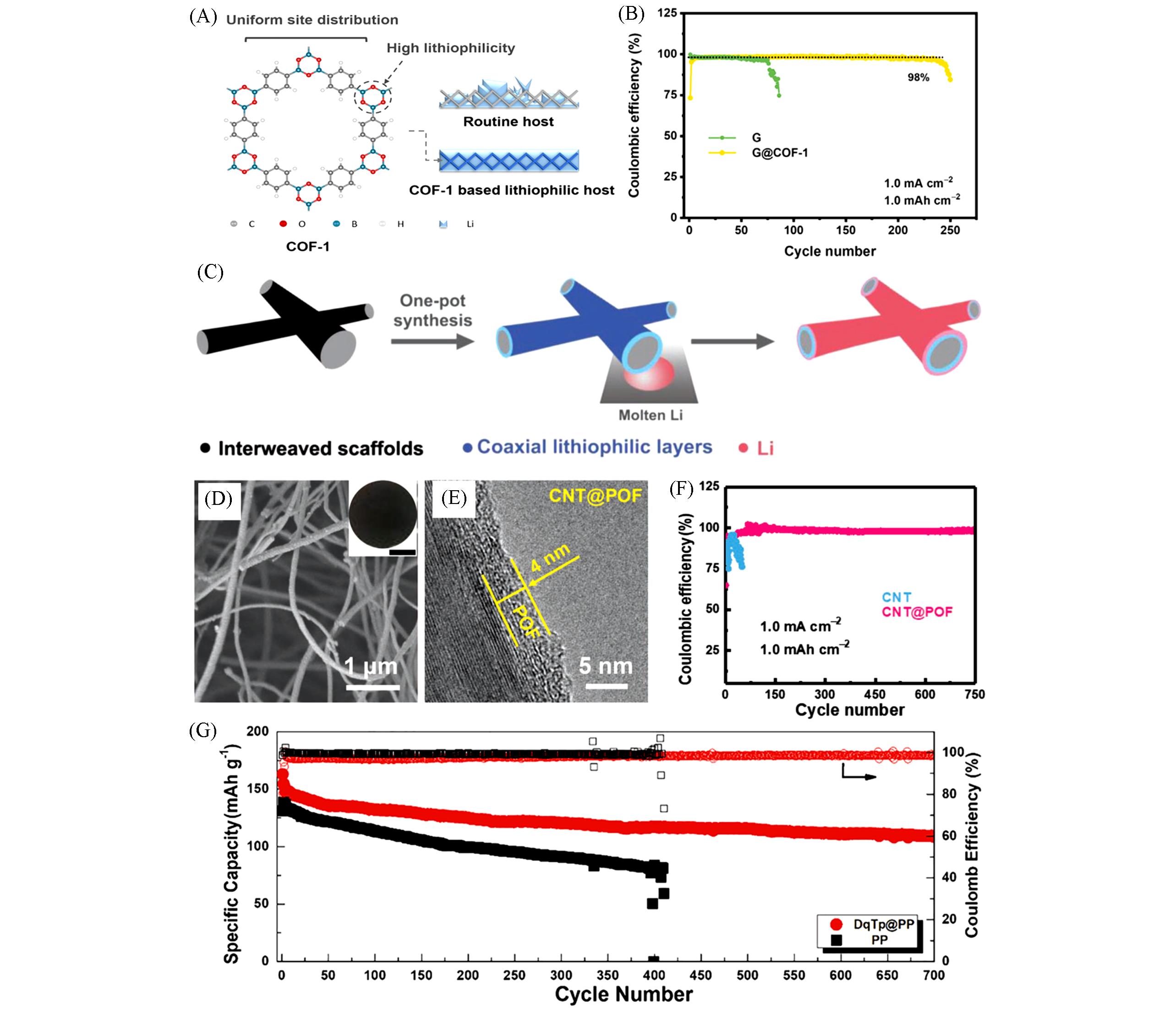
Fig.8 COF⁃1 provides well⁃defifined lithiophilic boroxine rings and uniform site distribution to guide uniform Li deposition, thereby affording dendrite⁃free morphology(A), cycling CE of half⁃cells with G or G@COF⁃1 electrodes(B)[131], fabrication of the CNT@POF⁃Li anode(C), SEM(D) and TEM(E) images of CNT@POF, cycling performances of the CNT@POF and CNT scaffold at 1.0 mA·cm-2, 1.0 mA·h·cm-2 in half cells(F)[132], and the long⁃term cycling performances of Li⁃LFP batteries with DqTp@PP and PP separators at 0.5 C(G)[133]Insets of (D): digital photos of the CNT@POF scaffold. (A, B) Copyright 2020 Elsevier; (C—E) Copyright 2019, Wiley-VCH Verlag GmbH & Co. KGaA, Weinheim; (G) Copyright 2022, Elsevier.
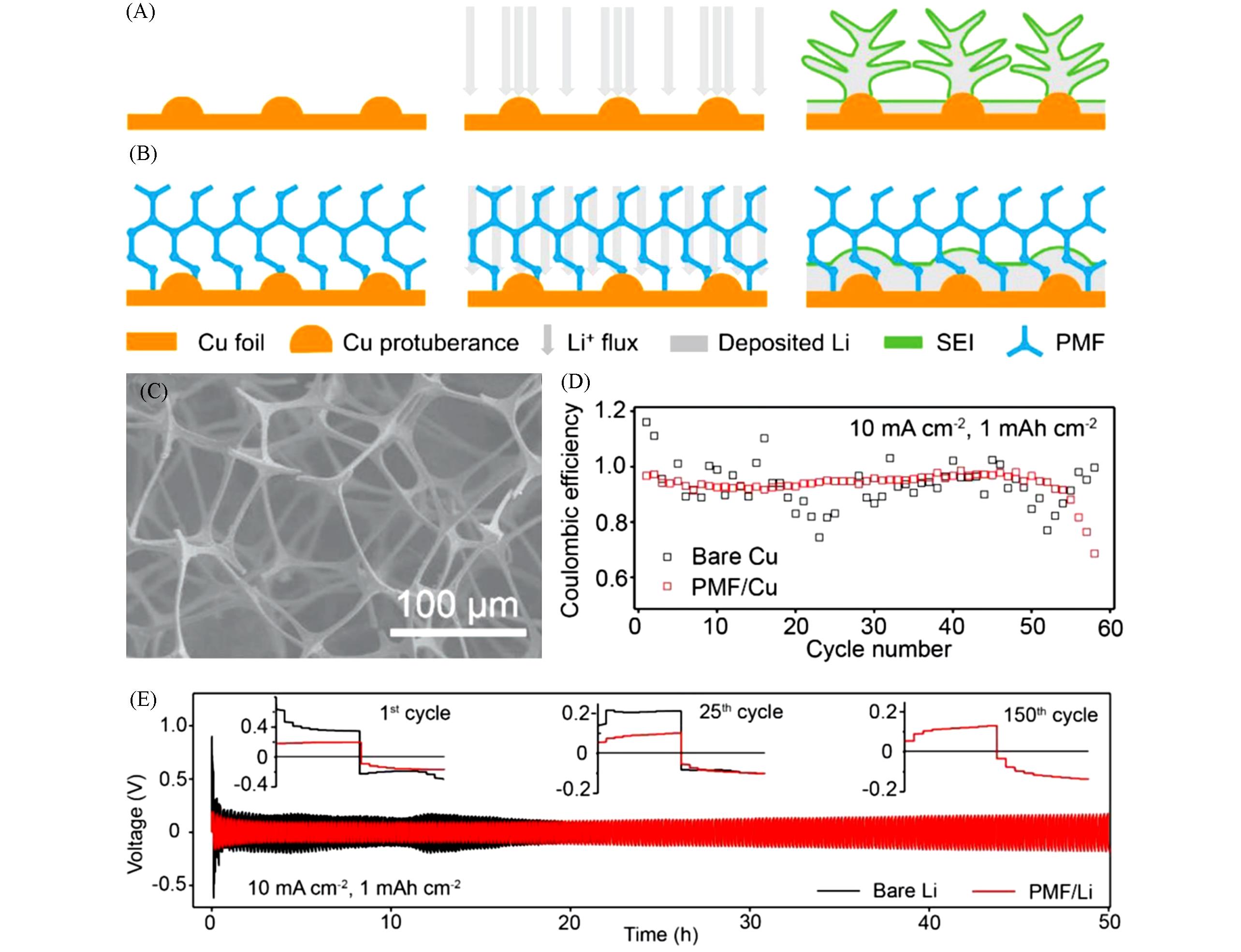
Fig.9 Lithium deposits on copper foil directly(A) and through PMF(B), SEM image of PMF(C), Lithium Coulombic efficiency of Li/Cu cells with or without the protection of 3D PMF host at 10 mA/cm2 with a fixed lithiation capacity of 1 mA·h·cm-2(D), voltage profiles under a current density of 10 mA/cm2 with a fixed capacity of 1 mA·h·cm-2(E)[138]Insets of (E): detailed voltage profiles with cycle number indicated. (A—E) Copyright 2018, Wiley-VCH Verlag GmbH & Co. KGaA, Weinheim
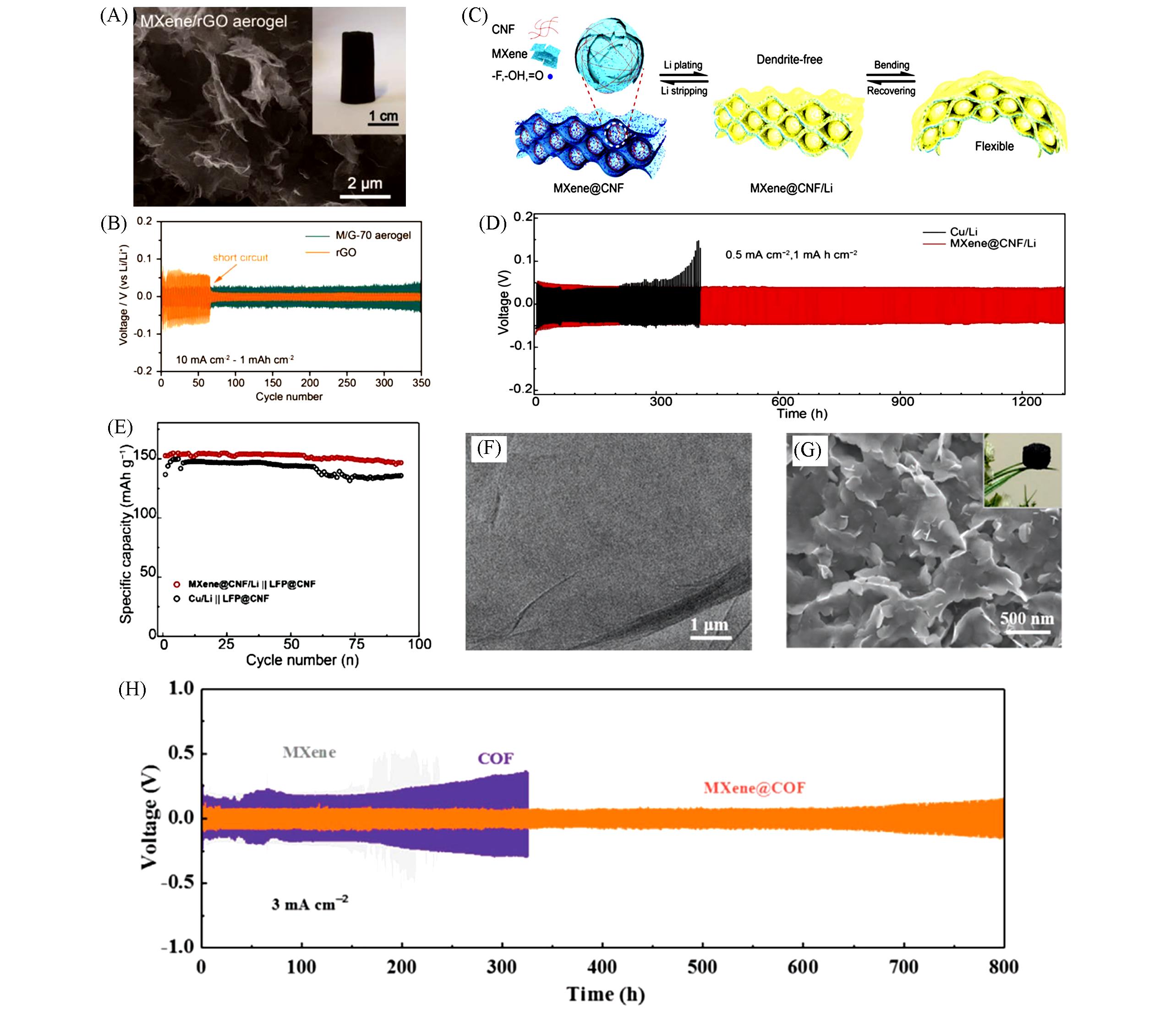
Fig.10 SEM image of the Ti3C2/rGO aerogel(A), voltage profiles of the symmetric cells with rGO and M/G⁃70 aerogel scaffolds at current density of 10 mA/cm2 under deposition capacity of 1 mA·h·cm-2(B)[140], schematic illustration of lithium plating on MXene@CNF film(C), galvanostatic plating/stripping profiles in MXene@CNF/Li and Cu/Li symmetric cells(D), the cycling performance of the MXene@ CNF/Li||LFP@CNF full cell at 0.2 C(E)[139], TEM image of MXene@COF nanosheets(F), SEM image of MXene@COF aerogel(G) and cycling voltage profiles of symmetric cells at 3 mA/cm2(H)[142]Inset of (G): photograph of an ultralight MXene@COF scaffold standing on a leaf. (A, B) Copyright 2018, Wiley-VCH Verlag GmbH & Co. KGaA, Weinheim; (C—E) Copyright 2020, Elsevier; (F—H) Copyright 2021, Wiley-VCH Verlag GmbH & Co. KGaA, Weinheim.
| 3D framework/Li electrode | CE(%)/currentdensity/(mA·cm-2)/lifespan(cycles) | Overpotentials/mV/current density/(mA·cm-2)/time/h | Ref. |
|---|---|---|---|
| Mesh Cu fibers current collector | 97/0.5/50 | 60/0.2/600 | [ |
| HP⁃Cu@Sn current collector | 96.9/3/130 | 40/1/800 | [ |
| 3D Li⁃Ni anode | — | 200/1/200 | [ |
| 3D Li⁃B⁃Mg anode | — | 120/2/70 | [ |
| 3D graphene/Ag composite skeleton | 97.3/1/50 | 118/40/50 | [ |
| SiO2/TiO2/C porous core⁃shell fibers | — | 34.7/4/350(cycles) | [ |
| ZnO modified brass mesh | 97.5/1/100 | 80/2/500 | [ |
| Nano porous N⁃doped graphene | 96/1/200 | 100/5/127 | [ |
| Boro⁃oxicyclic frame/graphene | 98/3/50 | — | [ |
| 3D porous poly melamine⁃formaldehyde(PMF) skeleton | 91/10/40 | 40/10/50 | [ |
| Ultra⁃thin flexibility MXene@CNF/Li composite anode | 98.9/0.5/200 | 100/0.5/1200 | [ |
| 3D porous BN/C skeleton | 97.8/4/500 | 60/4/500 | [ |
Table 1 Coulombic efficiency(CE) and overpotential of different 3D frameworks for Li metal anode
| 3D framework/Li electrode | CE(%)/currentdensity/(mA·cm-2)/lifespan(cycles) | Overpotentials/mV/current density/(mA·cm-2)/time/h | Ref. |
|---|---|---|---|
| Mesh Cu fibers current collector | 97/0.5/50 | 60/0.2/600 | [ |
| HP⁃Cu@Sn current collector | 96.9/3/130 | 40/1/800 | [ |
| 3D Li⁃Ni anode | — | 200/1/200 | [ |
| 3D Li⁃B⁃Mg anode | — | 120/2/70 | [ |
| 3D graphene/Ag composite skeleton | 97.3/1/50 | 118/40/50 | [ |
| SiO2/TiO2/C porous core⁃shell fibers | — | 34.7/4/350(cycles) | [ |
| ZnO modified brass mesh | 97.5/1/100 | 80/2/500 | [ |
| Nano porous N⁃doped graphene | 96/1/200 | 100/5/127 | [ |
| Boro⁃oxicyclic frame/graphene | 98/3/50 | — | [ |
| 3D porous poly melamine⁃formaldehyde(PMF) skeleton | 91/10/40 | 40/10/50 | [ |
| Ultra⁃thin flexibility MXene@CNF/Li composite anode | 98.9/0.5/200 | 100/0.5/1200 | [ |
| 3D porous BN/C skeleton | 97.8/4/500 | 60/4/500 | [ |
| 1 | Wu F., Maier J., Yu Y., Chem. Soc. Rev., 2020, 49(5), 1569—1614 |
| 2 | Jung S. K., Hwang I., Chang D., Park K. Y., Kim S. J., Seong W. M., Eum D., Park J., Kim B., Kim J., Heo J. H., Kang K., Chem. Rev., 2020, 120(14), 6684—6737 |
| 3 | Wang Z. M., Meng C., Yu R. B., Chem. J. Chinese Universities, 2022, 43(11), 20220544 |
| 王祖民, 孟程, 于然波. 高等学校化学学报, 2022, 43(11), 20220544 | |
| 4 | Yuan M., Zhao Y. J., Wu Y. C., Jiang L., Chem. J. Chinese Universities, 2022, 43(11), 20220448 |
| 袁萌, 赵英杰, 吴雨辰, 江雷. 高等学校化学学报, 2022, 43(11), 20220448 | |
| 5 | Cheng X. B., Zhang R., Zhao C. Z., Zhang Q., Chem. Rev., 2017, 117(15), 10403—10473 |
| 6 | Zhang J. G., Xu W., Xiao J., Cao X., Liu J., Chem. Rev., 2020, 120(24), 13312—13348 |
| 7 | Gu X., Lai C., Energy Stor. Mater., 2019, 23, 190—224 |
| 8 | Zuo J. H., Gong Y. J., Tungsten, 2020, 2(2), 134—146 |
| 9 | Cheng Y., Chen J., Chen Y., Ke X., Li J., Yang Y., Shi Z., Energy Stor. Mater., 2021, 38, 276—298 |
| 10 | Lang J., Qi L., Luo Y., Wu H., Energy Stor. Mater., 2017, 7, 115—129 |
| 11 | Yang H., Guo C., Naveed A., Lei J., Yang J., Nuli Y., Wang J., Energy Stor. Mater., 2018, 14, 199—221 |
| 12 | Yang C., Fu K., Zhang Y., Hitz E., Hu L., Adv. Mater., 2017, 29(36), 1701169 |
| 13 | Zhang R., Li N. W., Cheng X. B., Yin Y. X., Zhang Q., Guo Y. G., Adv. Sci., 2017, 4(3), 1600445 |
| 14 | Dai H., Gu X. X., Dong J., Wang C., Lai C., Sun S. H., Nat. Commun., 2020, 11(1), 643 |
| 15 | Cheng X. B., Zhao C. Z., Yao Y. X., Liu H., Zhang Q., Chem., 2019, 5(1), 74—96 |
| 16 | Qian S. S., Xing C., Zheng M. T., Su Z., Chen H., Wu Z. Z, Lai C., Zhang S. Q., Adv. Energy Mater., 2022, 12(15), 2103480 |
| 17 | Shi P., Liu Z. Y., Zhang X. Q., Chen X., Yao N., Xie J., Jin C. B., Zhan Y. X., Ye G., Huang J. Q., Zhang Q., J. Energy Chem., 2022, 64, 172—178 |
| 18 | Shen X., Cheng X. B., Shi P., Huang, J. Q., Zhang, X. Q., Yan C., Li T., Zhang Q., J. Energy Chem., 2019, 37, 29—34 |
| 19 | Wang S. Z., Wang Y., Song Y. C., Zhang J. T., Jia X. H., Yang J., Shao D., Li Y., Liao J. X., Song H. J., Energy Stor. Mater., 2022, 50, 505—513 |
| 20 | Chen C., Guan J., Li N. W., Lu Y., Luan D. Y., Zhang C. H., Cheng G., Yu L., Lou X. W., Adv. Mater., 2021, 33(24), 2100608 |
| 21 | Jiang P. X., Liao Y. F., Liu W., Chen Y. G., J. Energy Chem., 2021, 57, 131—139 |
| 22 | Li S. Q., Zhang L., Liu T. T., Zhang Y. W., Guo C. F., Wang Y., Du F. H., Adv. Mater., 2022, 34(24), 2201801 |
| 23 | Ye H., Zheng Z. J., Yao H. R., Liu S. C., Zuo T. T., Wu X. W., Yin Y. X., Li N. W., Gu J. J., Cao F. F., Guo Y. G., Angew. Chem. Int. Edit., 2019, 58(4), 1094—1099 |
| 24 | Jin S., Jiang Y., Ji H., Yu Y., Adv. Mater., 2018, 30(48), 1802014 |
| 25 | Park S., Jin H. J., Yun Y. S., Adv. Mater., 2020, 32(51), 2002193 |
| 26 | Wu N., Zhang Q. Y., Guo Y. J., Zhou L., Zhang L. J., Wu M. X., Wang W. P., Yin Y. X., Sheng P., Xin S., Rare Met., 2022, 41(7), 2217—2222 |
| 27 | Chen J., Xu X., He Q., Ma Y., Chem. Res. Chinese Universities, 2020, 36(3), 386—401 |
| 28 | Zhang R., Chen X., Shen X., Zhang X. Q., Chen X. R., Cheng X. B., Yan C., Zhao C. Z., Zhang Q., Joule, 2018, 2(4), 764—777 |
| 29 | Ni S., Tan S., An Q., Mai L., J. Energy Chem., 2020, 44, 73—89 |
| 30 | Ma Y., Wei L., He Y., Yuan X. Z., Su Y. H., Gu Y. T., Li X. J., Zhao X. H., Qin Y. Z., Mu Q. Q., Peng Y., Sun Y., Deng Z., Angew. Chem. Int. Edit., 2022, 61(12), e202116291 |
| 31 | Huang M., Yao Z., Yang Q., Li C., Angew. Chem., 2021, 133(25), 14159—14169 |
| 32 | Huang W., Yu Y. K., Hou Z., Liang Z. J., Zheng Y. Y., Quan Z. W., Lu Y. C., Energy Stor. Mater., 2020, 33, 329—335 |
| 33 | Yang J., Feng T. T., Hou J. M., Li X. R., Chen B. Y., Chen C., Chen Z., Song Y. C., Wu M. Q., J. Energy Chem., 2022, 65, 583—591 |
| 34 | Pathak R., Zhou Y., Qiao Q., Appl. Sci. Basel, 2020, 10(12), 4185 |
| 35 | Gu X., Dong J., Lai C., Eng. Rep., 2020, 3(1), e12339 |
| 36 | Zhang L., Zheng H. F., Liu B., Xie Q. S., Chen Q. L., Lin L., Lin J., Qu B. H., Wang L. S., Peng D. L., J. Energy Chem., 2021, 57, 392—400 |
| 37 | Wang S. H., Yue J., Dong W., Zuo T. T., Li J. Y., Liu X., Zhang X. D., Liu L., Shi J. L., Yin Y. X., Guo Y. G., Nat. Commun., 2019, 10(1), 4930 |
| 38 | Zhang W., Jin H., Xu C., Zhao S., Du Y., Zhang J., J. Power Sources, 2019, 440, 227142 |
| 39 | Xu Y., Menon A. S., Harks P. P. R. M. L., Hermes D. C., Haverkate L. A., Unnikrishnan S., Mulder F. M., Energy Stor. Mater., 2018, 12, 69—78 |
| 40 | Lu L. L., Ge J., Yang J. N., Chen S. M., Yao H. B., Zhou F., Yu S. H., Nano Lett., 2016, 16(7), 4431—4437 |
| 41 | Yang C. P., Yin Y. X., Zhang S. F., Li N. W., Guo Y. G., Nat. Commun., 2015, 6, 8058 |
| 42 | Zhang X., Wang A., Lv R., Luo J., Energy Stor. Mater., 2019, 18, 199—204 |
| 43 | Yan K., Lu Z., Lee H. W., Xiong F., Hsu P. C., Li Y., Zhao J., Chu S., Cui Y., Nat. Energy, 2016, 1, 16010 |
| 44 | Luo Z., Liu C., Tian Y., Zhang Y., Jiang Y., Hu J., Hou H., Zou G., Ji X., Energy Stor. Mater., 2020, 27, 124—132 |
| 45 | Zhang D., Dai A., Fan B., Li Y., Shen K., Xiao T., Hou G., Cao H., Tao X., Tang Y., ACS Appl. Mater. Interf., 2020, 12(28), 31542—31551 |
| 46 | Song Y. X., Lu W. Y., Chen Y. J., Yang H., Wu C., Wei W. F., Chen L. B., Ouyang X. P., Rare Met., 2021, 41(4), 1255—1264 |
| 47 | Ye Y., Liu Y., Wu J., Yang Y., J. Power Sources, 2020, 472, 228520 |
| 48 | Cheng Y., Ke X., Chen Y., Huang X., Shi Z., Guo Z., Nano Energy, 2019, 63, 103854 |
| 49 | Hou G., Sun Q., Ai Q., Ren X., Xu X., Guo H., Guo S., Zhang L., Feng J., Ding F., Ajayan P. M., Si P., Ci L., J. Power Sources, 2019, 416, 141—147 |
| 50 | Chen J., Xiang J., Chen X., Yuan L., Li Z., Huang Y., Energy Stor. Mater., 2020, 30, 179—186 |
| 51 | Liu Y., Huang S., Wang B., Yang Y., Cao G., Xiong Y., Zhang H., Sustain. Energy Fuels, 2019, 3(11), 2995—2999 |
| 52 | Cheng H., Gao C., Cai N., Wang M., Chem. Commun., 2021, 57(30), 3708—3711 |
| 53 | Yang H., Chen L., Ni X., Chen Y., Niu J., Mei L., J. Alloys Compd., 2022, 910, 164925 |
| 54 | Hou Z., Yu Y., Wang W., Zhao X., Di Q., Chen Q., Chen W., Liu Y., Quan Z., ACS Appl. Mater. Interf., 2019, 11(8), 8148—8154 |
| 55 | Fan H., Gao C., Dong Q., Hong B., Fang Z., Hu M., Lai Y., J. Electroanal. Chem., 2018, 824, 175—180 |
| 56 | Guan R., Liu S., Wang C., Yang Y., Lu D., Bian X., Chem. Eng. J., 2021, 425, 130177 |
| 57 | Wang R., Shi F., He X., Shi J., Ma T., Jin S., Tao Z., Sci. Chin. Mater., 2020, 64(5), 1087—1094 |
| 58 | Liu T., Chen X., Zhan C., Cao X., Wang Y., Liu J. H., ChemNanoMat, 2020, 6(8), 1200—1207 |
| 59 | Xu X., Zeng Q., Liu H., Wen K., Huang M., Jia M., Liu F., Mater. Lett., 2021, 294, 129705 |
| 60 | Chi S. S., Liu Y., Song W. L., Fan L. Z., Zhang Q., Adv. Funct. Mater., 2017, 27(24), 1700348 |
| 61 | Wu C., Huang H., Lu W., Wei Z., Ni X., Sun F., Qing P., Liu Z., Ma J., Wei W., Chen L., Yan C., Mai L., Adv. Sci., 2020, 7(6), 1902643 |
| 62 | Wu Y., Zhang Y., Liu Y., Feng J., Energy Technol., 2021, 9(8), 2100087 |
| 63 | Chen X. R., Chen X., Yan C., Zhang X. Q., Zhang Q., Huang J. Q., Energy & Fuels, 2021, 35(15), 12746—12752 |
| 64 | Liu S., Ma Y., Zhou Z., Lou S., Huo H., Zuo P., Wang J., Du,C., Yin G., Gao Y., Energy Stor. Mater., 2020, 33, 423—431 |
| 65 | Guo F., Wu C., Chen H., Zhong F., Ai X., Yang H., Qian J., Energy Stor. Mater., 2020, 24, 635—643 |
| 66 | Chen T., Meng F., Zhang Z., Liang J., Hu Y., Kong W., Zhang X. L., Jin Z., Nano Energy, 2020, 76, 105068 |
| 67 | Song R., Ge Y., Wang B., Lv Q., Wang F., Ruan T., Wang D., Dou S., Liu H., J. Mater. Chem. A, 2019, 7(30), 18126—18134 |
| 68 | Liu T., Hu Q., Li X., Tan L., Yan G., Wang Z., Guo H., Liu Y., Wu Y., Wang J., J. Mater. Chem. A, 2019, 7(36), 20911—20918 |
| 69 | Kong L. L., Wang L., Ni Z. C., Liu S., Li G. R., Gao X. P., Adv. Funct. Mater., 2019, 29(13), 1808756 |
| 70 | Wang S., Wang Y., Song Y., Zhang J., Jia X., Yang J., Shao D., Li Y., Liao J., Song H., Energy Stor. Mater., 2022, 50, 505—513 |
| 71 | Lu C., Tian M., Zheng X., Wei C., Rummeli M. H., Strasser P., Yang R., Chem. Eng. J., 2022, 430, 132722 |
| 72 | Wondimkun Z. T., Tegegne W. A., Shi⁃Kai J., Huang C. J., Sahalie N. A., Weret M. A., Hsu J. Y., Hsieh P. L., Huang Y. S., Wu S. H., Su W. N., Hwang B. J., Energy Stor. Mater., 2021, 35, 334—344 |
| 73 | Song H., He T., Liu J., Wang Y., Li X. L., Liu J., Zhang D., Yang H. Y., Hu J., Huang S., Carbon, 2021, 181, 99—106 |
| 74 | Li S., Jiang P., Wang K., Sun C., Tang X., Wu W., Zhao W., Zhao T., Ma Y., Wei B., Chem. Eng. J., 2021, 417, 127915 |
| 75 | Guo W., Han Q., Jiao J., W, W., Zhu X., Chen Z., Zhao Y., Angew. Chem. Int. Ed., 2021, 60(13), 7267—7274 |
| 76 | Fang Y., Zhang S. L., Wu Z. P., Luan D., Lou X. W. D., Sci. Adv., 2021, 7(21), eabg3626 |
| 77 | Tan L., Feng S., Li X., Wang Z., Peng W., Liu T., Yan G., Li L., Wu F., Wang J., Chem. Eng. J., 2020, 394, 124848 |
| 78 | Ma Y., Jing Y., Gu Y., Qi P., Lian Y., Yang C., Abdul Razzaq A., Zhao X., Peng Y., Zeng X., Li J., Deng Z., ACS Appl. Mater. Interf., 2020, 12(8), 9355—9364 |
| 79 | Li Y., Wang Y., Shi Y., Wu H., Zeng J., Bu H., Zhu M., Xiao C., Zhang Y., Gao G., Ding S., Science Bulletin, 2020, 65(13), 1094—1102 |
| 80 | Jia W., Wang Z., Li J., Yu X., Wei Y., Yao Z., Liu Y., Wang Y., Zhou A., Zou W., Zhou F., Li H., J. Mater. Chem. A, 2019, 7(39), 22377—22384 |
| 81 | Chen,T., Kong W., Zhao P., Lin H., Hu Y., Chen R., Yan W., Jin Z., Chem. Mater., 2019, 31(18), 7565—7573 |
| 82 | Lu L. L., Zhang Y., Pan Z., Yao H. B., Zhou F., Yu S. H., Energy Stor. Mater., 2017, 9, 31—38 |
| 83 | Xue P., Liu S., Shi X., Sun C., Lai C., Zhou Y., Sui D., Chen Y., Liang J., Adv. Mater., 2018, 30(44), e1804165 |
| 84 | Jin C., Sheng O., Luo J., Yuan H., Fang C., Zhang W., Huang H., Gan Y., Xia Y., Liang C., Zhang J., Tao X., Nano Energy, 2017, 37, 177—186 |
| 85 | Wu S., Zhang Z., Lan M., Yang S., Cheng J., Cai J., Shen J., Zhu Y., Zhang K., Zhang W., Adv. Mater., 2018, 30(9), 1705830 |
| 86 | Zhang C., Lv W., Zhou G., Huang Z., Zhang Y., Lyu R., Wu H., Yun Q., Kang F., Yang Q. H., Adv. Energy Mater., 2018, 8(21), 1703404 |
| 87 | Zhang H., Liao X., Guan Y., Xiang Y., Li M., Zhang W., Zhu X., Ming H., Lu L., Qiu J., Huang Y., Cao G., Yang Y., Mai L., Zhao Y., Zhang H., Nat. Commun., 2018, 9(1), 3729 |
| 88 | Huang S., Zhang W., Ming H., Cao G., Fan L. Z., Zhang H., Nano Lett., 2019, 19(3), 1832—1837 |
| 89 | Lu W., Wu C., Wei W., Ma J., Chen L., Chen Y., J. Mater. Chem. A, 2019, 7(42), 24262—24270 |
| 90 | Tantratian K., Cao D., Abdelaziz A., Sun X., Sheng J., Natan A., Chen L., Zhu H., Adv. Energy Mater., 2019, 10(5), 1902819 |
| 91 | Xue P., Sun C., Li H., Liang J., Lai C., Adv. Sci., 2019, 6(18), 1900943 |
| 92 | Gong Z., Lian C., Wang P., Huang K., Zhu K., Ye K., Yan J., Wang G., Cao D., Energy Environ. Mater., 2021, 5(4), 1270—1277 |
| 93 | Lu L. Q., Pei Y. T., Mater. Today Energy, 2021, 21, 100748 |
| 94 | Qiu X., Yu M., Fan G., Liu J., Wang Y., Zhao K., Ding J., Cheng F., ACS Appl. Mater. Interf., 2021, 13(5), 6367—6374 |
| 95 | Yu B., Fan Y., Mateti S., Kim D., Zhao C., Lu S., Liu X., Rong Q., Tao T., Tanwar K. K., Tan X., Smith S. C., Chen Y. I., ACS Nano, 2021, 15(1), 1358—1369 |
| 96 | Cai Y., Qin B., Li C., Si X., Cao J., Zheng X., Qi J., Chem. Eng. J., 2022, 433, 133689 |
| 97 | Liu Y., Sun J., Hu X., Li Y., Du H., Wang K., Du Z., Gong X., Ai W., Huang W., Nano Energy, 2022, 94, 106883 |
| 98 | Wang D., Lv D., Liu H., Yang J., Qian Y., Chen Z., Energy Stor. Mater., 2022, 49, 454—462 |
| 99 | Chen Q., Chen S., Zhao L., Ma J., Wang H., Zhang J., Chem. Eng. J., 2022, 431, 133961 |
| 100 | Zhang X., Chen Y., Yu B., Wang B., Wang X., Zhang W., Yang D., He J., ACS Appl. Mater. Interf., 2021, 13(17), 20125—20136 |
| 101 | Wang Y., Zhang W., Qi Y., Wang S., Liu P., Wei X., Yu Y., Sun W., Zhao X. Z., Liu Y., J. Alloys Compd., 2021, 874, 159916 |
| 102 | Jiang H., Fan H., Han Z., Hong B., Wu F., Zhang K., Zhang Z., Fang J., Lai Y., J. Energy Chem., 2021, 54, 301—309 |
| 103 | Han Y., Sang Z., Liu D., Zhang T., Feng J., Si W., Dou S. X., Liang J., Hou F., Chem. Eng. J., 2021, 420, 129787 |
| 104 | Park H., Kwon J., Song T., Paik U., J. Power Sources, 2020, 477, 129787 |
| 105 | Zhu J., Chen J., Luo Y., Sun S., Qin L., Xu H., Zhang P., Zhang W., Tian W., Sun Z., Energy Stor. Mater., 2019, 23, 539—546 |
| 106 | Luo L., Li J., Yaghoobnejad Asl H., Manthiram A., Adv. Mater., 2019, 31(48), e1904537 |
| 107 | Lei M., Wang J. G., Ren L., Nan D., Shen C., Xie K., Liu X., ACS Appl. Mater. Interf., 2019, 11(34), 30992—30998 |
| 108 | Liu H., Chen X., Cheng X. B., Li B. Q., Zhang R., Wang B., Chen X., Zhang Q., Small Meth., 2018, 3(9), 1800354 |
| 109 | Zhang C., Lyu R., Lv W., Li H., Jiang W., Li J., Gu S., Zhou G., Huang Z., Zhang Y., Wu J., Yang Q. H., Kang F., Adv. Mater., 2019, 31(48), e1904991 |
| 110 | Wu T., Wang Y., Zhang W., Lu K., Tan J., Zheng M., Xiao Y., Liu Y., Liang Y., J. Energy Chem., 2022, 71, 324—332 |
| 111 | Song M. K., Yim J. H., Baek S. H., Lee J. W., Appl. Surf. Sci., 2022, 588, 152935 |
| 112 | Chen X., Xie J., Lu Y., Zhao X., Zhu T., J. Materiomics, 2021, 7(2), 355—365 |
| 113 | Zhang A., Fang X., Shen C., Liu Y., Zhou C., Nano Research, 2016, 9(11), 3428—3436 |
| 114 | Zhang C., Huang Z., Lv W., Yun Q., Kang F., Yang Q. H., Carbon, 2017, 123, 744—755 |
| 115 | Ai W., Luo Z., Jiang J., Zhu J., Du Z., Fan Z., Xie L., Zhang H., Huang W., Yu T., Adv. Mater., 2014, 26(35), 6186—6192 |
| 116 | Lin D., Liu Y., Liang Z., Lee H. W., Sun J., Wang H., Yan K., Xie J., Cui Y., Nat. Nanotechnol., 2016, 11(7), 626—632 |
| 117 | Wang H., Zhang C., Liu Z., Wang L., Han P., Xu H., Zhang K., Dong S., Yao J., Cui G., J. Mate. Chem., 2011, 21(14), 5430—5434 |
| 118 | Zhang R., Chen X. R., Chen X., Cheng X. B., Zhang X. Q., Yan C., Zhang Q., Angew. Chem. Int. Ed., 2017, 56(27), 7764—7768 |
| 119 | Dong Q., Hong B., Fan H., Gao C., Hong S., Lai Y., Electrochimica Acta, 2018, 284, 376—381 |
| 120 | Chen X., Chen X. R., Hou T. Z., Li B. Q., Cheng X. B., Zhang R., Zhang Q., Sci. Adv., 2019, 5(2), eaau7728 |
| 121 | Huang G., Han J., Zhang F., Wang Z., Kashani H., Watanabe K., Chen M., Adv. Mater., 2019, 31(2), e1805334 |
| 122 | Cote A. P., Benin A. I., Ockwig N. W., O'Keeffe M., Matzger A. J., Yaghi O. M., Science, 2005, 310(5751), 1166—1170 |
| 123 | Vitaku E., Dichtel W. R., J. Am. Chem. Soc., 2017, 139(37), 12911—12914 |
| 124 | Zhi Y., Wang Z., Zhang H. L., Zhang Q., Small, 2020, 16(24), e2001070 |
| 125 | Chen D., Huang S., Zhong L., Wang S., Xiao M., Han D., Meng Y., Adv. Funct. Mater., 2019, 30(7), 1907717 |
| 126 | Lin Z. Q., Xie J., Zhang B. W., Li J. W., Weng J., Song R. B., Huang X., Zhang H., Li H., Liu Y., Xu Z. J., Huang W., Zhang Q., Nano Energy, 2017, 41, 117—127 |
| 127 | Sun T., Xie J., Guo W., Li D. S., Zhang Q., Adv. Energy Mater., 2020, 10(19), 1904199 |
| 128 | Xie H., Hao Q., Jin H., Xie S., Sun Z., Ye Y., Zhang C., Wang D., Ji H., Wan L. J., Sci. China Chem., 2020, 63(9), 1306—1314 |
| 129 | Xu Y., Zhou Y., Li T., Jiang S., Qian X., Yue Q., Kang Y., Energy Stor. Mater., 2020, 25, 334—341 |
| 130 | Yao C. J., Wu Z., Xie J., Yu F., Guo W., Xu Z. J., Li D. S., Zhang S., Zhang Q., ChemSusChem, 2020, 13(9), 2457—2463 |
| 131 | Song Y. W., Shi P., Li B. Q., Chen X., Zhao C. X., Chen W. J., Zhang X. Q., Chen X., Zhang Q., Matter, 2021, 4(1), 253—264 |
| 132 | Chen X. R., Li B. Q., Zhu C., Zhang R., Cheng X. B., Huang J. Q., Zhang Q., Adv. Energy Mater., 2019, 9(39), 1901932 |
| 133 | Li Z., Ji W., Wang T. X., Ding X., Han B. H., Feng W., Chem. Eng. J., 2022, 437, 135293 |
| 134 | Liu Y., Lin D., Liang Z., Zhao J., Yan K., Cui Y., Nat. Commun., 2016, 7, 10992 |
| 135 | Jiang J., Pan Z., Kou Z., Nie P., Chen C., Li Z., Li S., Zhu Q., Dou H., Zhang X., Wang J., Energy Stor. Mater., 2020, 29, 84—91 |
| 136 | Matsuda S., Kubo Y., Uosaki K., Nakanishi S., ACS Energy Lett., 2017, 2(4), 924—929 |
| 137 | Liang Z., Zheng G., Liu C., Liu N., Li W., Yan K., Yao H., Hsu P. C., Chu S., Cui Y., Nano Lett., 2015, 15(5), 2910—2916 |
| 138 | Fan L., Zhuang H. L., Zhang W., Fu Y., Liao Z., Lu Y., Adv. Energy Mater., 2018, 8(15), 1703360 |
| 139 | Wang C. Y., Zheng Z. J., Feng Y. Q., Ye H., Cao F. F., Guo Z. P., Nano Energy, 2020, 74, 104817 |
| 140 | Zhang X., Lv R., Wang A., Guo W., Liu X., Luo J., Angew. Chem. Int. Ed., 2018, 57(46), 15028—15033 |
| 141 | Zhang D., Wang S., Li B., Gong Y., Yang S., Adv. Mater., 2019, 31(33), e1901820 |
| 142 | Guo D., Ming F., Shinde D. B., Cao L., Huang G., Li C., Li Z., Yuan Y., Hedhili M. N., Alshareef H. N., Lai Z., Adv. Funct. Mater., 2021, 31(25), 2101194 |
| 143 | Tian Y., An Y., Wei C., Xi B., Xiong S., Feng J., Qian Y., ACS Nano, 2019, 13(10), 11676—11685 |
| 144 | Wei C., Fei H., Tian Y., An Y., Guo H., Feng J., Qian Y., Energy Stor. Mater., 2020, 26, 223—233 |
| 145 | Zhao Y., Li Q., Liu Z., Fan L., Li J., Ma Z., Qin X., Shao G., ACS Appl. Mater. Interfaces, 2020, 12(34), 37967—37976 |
| 146 | Xu Y., Li T., Wang L., and Kang Y., Adv. Mater., 2019, 31, 1901662 |
| 147 | Lu Z., Liang Q., Wang B., Tao Y., Zhao Y., Lv W., Liu D., Zhang C., Weng Z., Liang J., Li H., Yang Q. H., Adv. Energy Mater., 2019, 9(7), 1803186 |
| 148 | Li N., Wei W., Xie K., Tan J., Zhang L., Luo X., Yuan K., Song Q., Li H., Shen C., Ryan E. M., Liu L., Wei B., Nano Lett., 2018, 18(3), 2067—2073 |
| 149 | Jo I., Pettes M. T., Kim J., Watanabe K., Taniguchi T., Yao Z., Shi L., Nano Lett., 2013, 13, 550 |
| 150 | Li Q., Zhang G. Z., Liu F. H., Han K., Gadinski M. R., Xiong C. X., Wang Q., Energy Environ. Sci., 2015, 8, 922 |
| 151 | Luo W., Zhou L., Fu K., Yang Z., Wan J., Manno M., Yao Y., Zhu H., Yang B., Hu L., Nano Lett., 2015, 15, 6149—6154 |
| 152 | Cao D., Zhang Q., Hafez A. M., Jiao Y., Ma Y., Li H., Cheng Z., Niu C., Zhu H., Small Methods, 2019, 3(5), 1800539 |
| 153 | Liu Y., Sun C., Lu Y., Lin X., Chen M., Xie Y., Lai C., Yan W., Chem. Eng. J., 2023, 451, 138570 |
| 154 | Zhong Y., Huang P., Yan W., Su Z., Sun C., Xing Y., Lai C., Adv. Funct. Mater., 2021, 32(9), 2110347 |
| [1] | 张硕, 丁俊凡, 许睿, 黄佳琦. 金属锂负极溶剂化结构调控的研究进展[J]. 高等学校化学学报, 2023, 44(5): 20220721. |
| [2] | 李威, 罗飘, 黄廉湛, 崔志明. 基于聚苯乙烯磺酸的锂金属负极界面保护层的设计[J]. 高等学校化学学报, 2022, 43(8): 20220166. |
| [3] | 毛尔洋, 王莉, 孙永明. 锂离子电池高容量合金基含锂负极材料的研究进展[J]. 高等学校化学学报, 2021, 42(5): 1552. |
| [4] | 詹迎新, 石鹏, 张学强, 魏俊宇, 张乾魁, 黄佳琦. 锂金属负极亲锂骨架的研究进展[J]. 高等学校化学学报, 2021, 42(5): 1569. |
| [5] | 李曈, 谷思辰, 林乔伟, 韩俊伟, 周光敏, 李宝华, 康飞宇, 吕伟. 基于三维集流体的无枝晶锂金属负极[J]. 高等学校化学学报, 2021, 42(5): 1480. |
| [6] | 王增强, 孙一翎, 钱正芳, 王任衡. 基于表界面反应及优化的锂金属电池研究进展[J]. 高等学校化学学报, 2021, 42(4): 1017. |
| [7] | 王凤春, 周万里. 离子型添加剂四丁基胺-双(氟磺酰)亚胺对锂电池性能的影响[J]. 高等学校化学学报, 2018, 39(11): 2529. |
| [8] | 熊仕昭 谢凯 洪晓斌. 硝酸锂作添加剂对锂硫电池电化学性能的影响[J]. 高等学校化学学报, 2011, 32(11): 2645. |
| 阅读次数 | ||||||
|
全文 |
|
|||||
|
摘要 |
|
|||||